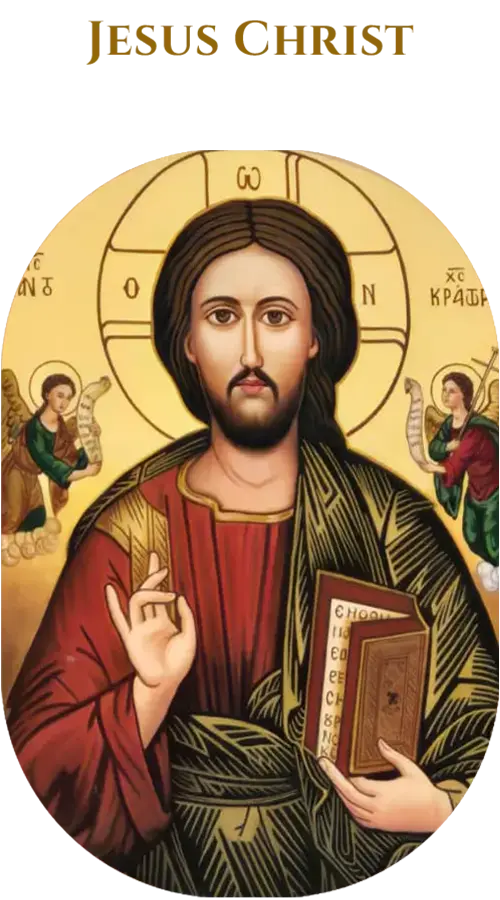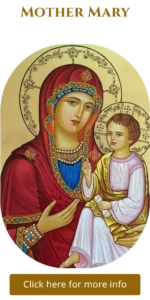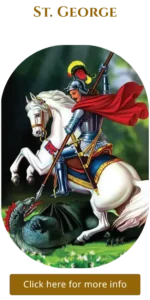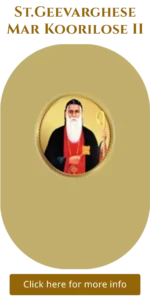Windows
- image from Mr.Salvis
Inside Paintings - East Altar
Orthodox image of Jesus Christ

Introduction
In the Syrian Orthodox tradition, images of Jesus Christ are central to worship and devotion, depicted through sacred icons that hold profound theological and spiritual significance.


Iconography of Jesus Christ in the Syrian Orthodox Tradition
• Theological Foundation: Icons of Jesus Christ are considered “windows to heaven,” not mere artworks but sacred representations that convey the reality of the Incarnation – Christ as fully divine and fully human. In the Syrian Orthodox tradition, icons are venerated (not worshipped) as a means of connecting with the divine presence, rooted in the theology of the Council of Chalcedon (451 CE) and earlier councils that affirmed Christ’s dual nature.
• Common Depictions:
– Christ Pantocrator (“Ruler of All”): One of the most prevalent images, showing Christ enthroned or standing, holding the Gospel book in one hand and blessing with the other. His face is serene yet authoritative, with large, expressive eyes symbolizing divine omniscience. The halo around His head often contains a cross and the Greek letters “IC XC” (Jesus Christ).
– Christ the Savior: Depicts Jesus with a compassionate expression, often with a golden or radiant background, emphasizing His role as Redeemer. This icon is common in churches and homes.
– Crucifixion: Shows Christ on the cross, often with the Virgin Mary and St. John the Evangelist at His sides, highlighting His sacrifice. The Syrian Orthodox style may include Syriac inscriptions and a focus on Christ’s triumph over death rather than suffering alone
– Nativity and Baptism: Icons of Christ’s birth and baptism in the Jordan are prominent during liturgical feasts, emphasizing key moments in His earthly life.
– Theotokos with Child: Christ is frequently depicted as an infant or child in the arms of the Virgin Mary (Mart Maryam), underscoring His humanity and her role as Theotokos (God-bearer).
– Artistic Style: Syrian Orthodox icons are characterized by
1. Byzantine Influence: Stylized, non-naturalistic forms with elongated figures, large eyes, and minimal perspective to convey spiritual rather than physical reality.
2. Syriac Elements: Use of Syriac script for inscriptions, vibrant colours (gold, red, blue), and symbolic motifs like the mandorla (almond-shaped aura) around Christ
3. Materials: Icons are typically painted on wood, sometimes adorned with silver or gold, and placed in churches or homes for veneration
Liturgical and Devotional Role
In Worship: Icons of Christ are central to the Syrian Orthodox liturgy, particularly in the Holy Qurbana (Eucharist). They are placed on the altar or in the sanctuary (madbho), where they are incensed and venerated during services. In the MISC, churches like St. George’s Cathedral in Thozhiyur and St. Mary’s Church at Perumannoor feature prominent icons of Christ, often alongside the Theotokos.
• Feasts and Seasons: Icons are highlighted during major feasts, such as:
– Nativity (Christmas, December 25): Icons of the infant Christ in the manger.
– Epiphany (Denho, January 6): Icons of Christ’s baptism.
– Great Lent and Holy Week: Icons of the Crucifixion and Resurrection are central to worship.
– Transfiguration (August 6): Icons of Christ glorified on Mount Tabor.
• Devotional Practices: Congregants venerate icons by bowing, kissing, or lighting lamps before them, seeking Christ’s intercession and blessings. Prayers like those in the Shehimo (daily prayers) often reference Christ’s divine and human natures, aligning with the theology depicted in icons.
Role in the MISC Context
The MISC, as a small church adhering to the West Syriac Rite, integrates Syrian Orthodox iconographic traditions into its worship and community life. Specific examples from the MISC’s history include:
• Church Dedications: Churches like St. George’s Cathedral (renovated under Joseph Mar Koorilose IX in 1989) and St. Mary’s Church at Perumannoor (completed under Paulose Mar Philoxenos III) likely house icons of Christ, reflecting their centrality in worship. The consecration of the Chennai church in 1981 under Mathews Mar Koorilose VIII would also have included Christ-centered iconography.
• 250th Anniversary (2022): During the MISC’s 250th anniversary celebration, presided over by Cyril Mar Baselios I, portraits of church fathers were unveiled, and icons of Christ likely played a prominent role in the liturgical events, given their importance in the West Syriac Rite.
• Gospel Association: The MISC’s Gospel Association, supported by Cyril Mar Baselios I, organizes retreats and conventions where icons of Christ are used as focal points for prayer and teaching, reinforcing His centrality in spiritual life.
Theological and Cultural Significance
• Incarnational Theology: Icons of Christ in the Syrian Orthodox tradition emphasize the reality of the Incarnation, countering early heresies like Nestorianism (which separated Christ’s natures). The MISC, aligned with this theology, uses icons to affirm Christ as the divine Logos who became human for salvation.
• Ecumenical Context: The MISC’s ecumenical engagements, as seen in the tenures of Joseph Mar Koorilose IX and Cyril Mar Baselios I, extend to shared veneration of Christ. For example, during visits to Anglican churches (e.g., Joseph Mar Koorilose IX’s meetings with Archbishops of Canterbury in 1989 and 1991), icons of Christ were likely part of joint Eucharistic celebrations, bridging Orthodox and Anglican traditions.
• Cultural Resonance: In Kerala’s Saint Thomas Christian community, icons of Christ are cherished in churches and homes, often adorned with flowers and lamps during feasts. The MISC’s small but devout community continues this tradition, with icons serving as spiritual anchors in parishes like Thozhiyur, Kunnamkulam, and Chennai.



